
Ukrainians in Kuban
Encyclopedia
Ukrainians in Kuban in southern Russia
constitute a significant national minority. The region as a whole shares many linguistic, cultural and historic ties with Ukraine
.
Ukrainians first settled the Kuban
in 1792 and until the mid-twentieth century the majority of the population there identified themselves as Little Russia
ns or Ukrainians
. Due to adverse Russian and Soviet national policies, including the Holodomor
, most of the population adopted a Russian self-identification, and the percentage of those who identified themselves as Ukrainians dropped from an official 55% (1926) to 0.9% (2002).
was given the rights to these lands by the Empress Katherine II
. According to the Ukaz of 30.6. and 1.7.1792 these lands were handed over to the Black Sea Cossacks "for eternity". These included the Phanagorian peninsula and the lands on the Right bank of the Kuban River
. From 1792-93 25,000 people settled the area, marking the first wave of Ukrainian settlement to Kuban. The Cossack navy consisting of 51 boats with 3247 people landed on the shores of Kuban on August 25, 1792. A second group of 600 people arrived with cattle overland. In October, 1792 under the command of otaman Zakhary Chepiha
a third group arrived. The final group arrived from Ukraine in 1793 under the command of Antin Holovaty
.
From 1806-09 about 562 Ukrainian Cossacks who had settled previously beyond the Danube were given a pardon and also arrived on the shores of the Taman peninsula.
 In 1809-11 41,635 settlers arrived from Poltava and Chernihiv. This marked the second wave of settlers from Ukraine. During the 3rd wave in 1820-25 59,455 people of both gender moved. The fourth wave of 11,949 people arrived from Kharkiv
In 1809-11 41,635 settlers arrived from Poltava and Chernihiv. This marked the second wave of settlers from Ukraine. During the 3rd wave in 1820-25 59,455 people of both gender moved. The fourth wave of 11,949 people arrived from Kharkiv
, Chernihiv
and Poltava
regions in 1848-9. In all from 1792-1850 105 thousand people moved to Kuban from Ukraine.
The lands settled by the Ukrainians were known as the Lands of the Black Sea Host. 40 kurin settlements were allowed, which not only were administrative units, but specific territories. The settlers from Ukraine founded the town, which became known as Yekaterinodar. In 1860 the Kuban oblast was formed.
After the February Revolution (1905) a temporary Kuban Military government was formed. Two sides struggled to obtain supremacy: a pro-Ukrainian and a pro-Russian faction. The pro-Ukrainian faction supported autonomy for Kuban and the formation of a Union with Ukraine. Also Ukrainian cultural life flowered. Ukrainian language school were opened and 6 newspapers began to publish in Ukrainian. In May 1918 a delegation headed by the head of the Kuban Rada M. Riabovol visited Kiev
. Diplomatic ties were announced between the Kuban People's Republic
and the Ukrainian People's Republic
.
To cement its hold in Kuban, the Soviet government allowed a period of Ukrainianisation in the 1920s where Ukrainian cultural life was allowed to flower. This was suddenly and brutally stopped in 1932.
In the census for 1926-7 there were 1,222,140 Ukrainians in the Kuban region, who made up 55% of the population of the area.
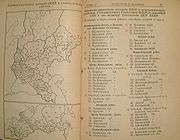
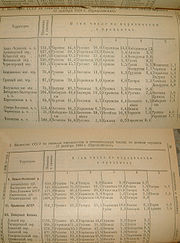
stated that the number of Ukrainians in the Kuban was understated and that they also made up 60% of those who put down Russian as their language were of Ukrainian ethnicity. The ethnographer and statistician O. Rusov also noted a similar number in his writings.
In the census for 1926 it was noted that there was a total population in the Kuban region of 3,343,893 of which 1,644.518 (49.2%) stated that they were Ukrainian, and 1,428,587 (42.7%) stated they were Russian.
Other figures from the same census state that Ukrainian speakers made up 55% of the population of the area.
In the 2002 Russian census it states that only 2% of the population speak Ukrainian and only 0.9% have been marked as being ethically Ukrainian.
. Some restrictions were relaxed in 1905 and others ceased to be policed for a short period of time after the Revolution in 1917.
In the Kuban with the repealing of formal restrictions by the Russian government on the use of Ukrainian language, the official use of the Ukrainian language began to bloom.
During the brief period of Kuban independence some 1391 beginning school, 180 middle schools, 151 high schools, 2 seminaries 124 professional tertiary establishments included education in the Ukrainian language.
By 1922 there were 33 schools that taught primarily in the Ukrainian language.
In 1927 there were 746 Ukrainian language schools. Ukrainian textbooks began to be published in Krasnodar
in 1926 with the crossing over of most institutes of higher learning to Ukrainian language instruction.
In 1920 in Krasnodar the first Institute of Folk Education (later renamed the Krasnodar Pedagogical Institute) was established. To better serve the local population, the medical institute was also Ukrainianized. A teachers college for the preparation of Ukrainian language teachers was also opened in 1922.
By 1927 there were 6 Institutes of higher learning that taught in Ukrainian.
Мost Ukrainians speaker speak a Ukrainian dialect, which differs only slightly from standard literary Ukrainian.
In 1921 the first Ukrainian language magazine “Zoria” was published. Ukrainian language newspapers were soon established such as “Novy shliakh”, “Chornomorets”, “Chornomorsky krai”. In the 1920s close to 150 Ukrainian language writers lived in the Kuban. All were repressed after 1932 either being shot or exiled.
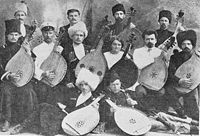
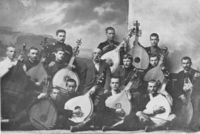
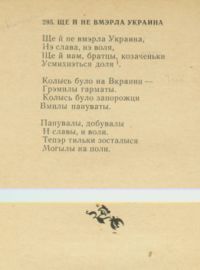 Music was one of the most important loves of the Ukrainians in the Kuban. There many Ukrainian folk songs sung in the Kuban. Many of the songs are about Cossack heroes from Ukraine, such as Morozenko, Baida, Doroshenko
Music was one of the most important loves of the Ukrainians in the Kuban. There many Ukrainian folk songs sung in the Kuban. Many of the songs are about Cossack heroes from Ukraine, such as Morozenko, Baida, Doroshenko
, Sahaidachny
, Bohdan Khmelnytsky
, Maksym Kryvonis, and Danylo Nechay
. A characteristic of Ukrainian folk songs of Kuban is the replacement of particular words to better reflect the local history and conditions. Where the word "Dunai" (the Danube) is used as a generic word for river, it is replaced by the word Kuban. Particularly popular are songs by the Sich Riflemen
from Galicia, composed in the early 20th century, which juxtapose the word "rifleman" (Strilets) with the word "Cossack" (Kozak).
In 1886 A. Bihdai published 14 books containing 556 Ukrainian folk songs. A similar publication named Malorusski pesni (Little-Russian (Ukrainian) songs) containing over 200 Ukrainian folk songs was collected by H. Kontsevych from singers of the Kuban Army choir. Close to 3,000 Ukrainian folk songs were recorded by in Kuban by Oleksander Koshetz
, who spent 3 years collecting materials.
In 1966 a collection of songs of the Kuban Cossacks published in Krasnodar included the text of "Shche ne vmerla Ukraina" - the Ukrainian Nationalist Anthem, which at that time was banned in Ukraine.
In the early 20th century a significant movement was organised for the support of people learning to play the Ukrainian folk instrument known as the bandura
. The bandura movement became quite significant until it was repressed in the 1930s. A number of Kuban bandurists were founding members of the first professional bandurist capella
organized in Kiev in 1918 under Vasyl Yemetz
. Kuban bandurists were also prominent in the formation of the second bandurist capella
in Prague
in 1923.
In recent times there has been a revival in the singing of Ukrainian folk songs led by the Kuban Cossack Choir
and its director, Viktor Zakharchenko. In a concert at the Ukraina Palace in Kiev in 1990, the Kuban Cossack Choir was the first to sing the Ukrainian National Anthem, which they announced as a Kuban folk song. Ukrainian folk instruments are no longer officially banned and are returning to use, being taught at the Krasnodar Music college.
as one of those involved in solving the nationalities question within the USSR put forward suggestions to Joseph Stalin:
However, the Ukrainization
policies of Kuban were abruptly reversed at the end of 1932. The December 14, 1932 publication of the grain procurement resolution of CK VKP(b)
and the Council of People's Commissars demanded the immediate transfer of all official paperwork and publishing of the "ukrainized" districts of Kuban into Russian language "more intelligible for the people of Kuban".
In 1932-33, the policies of forced collectivization
of the Ukrainian population of the Soviet Union, which caused a devastating famine that greatly affected the Ukrainian population of the Kuban.
The mass repressions of the 1930s also resulted in the arrest and execution of over 1500 Ukrainian speaking intellectuals from Krasnodar. Many teachers of Ukrainian language were arrested and exiled from the region. By 1932 all Ukrainian language education establishments were closed. The professional Ukrainian theatre in Krasnodar was closed.
All Ukrainian toponyms in the Kuban, which reflected the areas from which the first Ukrainians settlers had moved, were changed. The names of Stanytsias such. Kyivska was changed to Krasnoartilyevskaya, and Uman
ska to Leningradskaya, Poltavska
to Krasnoarmieiskaya.
The physical destruction of all aspects of Ukrainian culture and the Ukrainian population, and the resultant ethnic cleansing of the population, the terrorist tactics of Russification, the Holodomor of 1932-33 and 1946-7 and other tactics used by the Russian government lead to the catastrophic fall in population that associated themselves with Ukrainian ethnicity in the Kuban. Official Russian statistics of 1959 state that Ukrainians made up 4% of the population, in 1989 – 3%.
The number of self-identified Ukrainians in Kuban fell between 1927 to 2002 from 1,222,140 (55% of the 1927 total) to 61,867 (0.9% of the 2002 total).
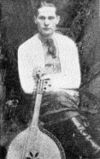
Russia
Russia or , officially known as both Russia and the Russian Federation , is a country in northern Eurasia. It is a federal semi-presidential republic, comprising 83 federal subjects...
constitute a significant national minority. The region as a whole shares many linguistic, cultural and historic ties with Ukraine
Ukraine
Ukraine is a country in Eastern Europe. It has an area of 603,628 km², making it the second largest contiguous country on the European continent, after Russia...
.
Ukrainians first settled the Kuban
Kuban
Kuban is a geographic region of Southern Russia surrounding the Kuban River, on the Black Sea between the Don Steppe, Volga Delta and the Caucasus...
in 1792 and until the mid-twentieth century the majority of the population there identified themselves as Little Russia
Little Russia
Little Russia , sometimes Little or Lesser Rus’ , is a historical political and geographical term in the Russian language referring to most of the territory of modern-day Ukraine before the 20th century. It is similar to the Polish term Małopolska of the Polish-Lithuanian Commonwealth...
ns or Ukrainians
Ukrainians
Ukrainians are an East Slavic ethnic group native to Ukraine, which is the sixth-largest nation in Europe. The Constitution of Ukraine applies the term 'Ukrainians' to all its citizens...
. Due to adverse Russian and Soviet national policies, including the Holodomor
Holodomor
The Holodomor was a man-made famine in the Ukrainian SSR between 1932 and 1933. During the famine, which is also known as the "terror-famine in Ukraine" and "famine-genocide in Ukraine", millions of Ukrainians died of starvation in a peacetime catastrophe unprecedented in the history of...
, most of the population adopted a Russian self-identification, and the percentage of those who identified themselves as Ukrainians dropped from an official 55% (1926) to 0.9% (2002).
Ukrainian settlement
Ukrainian settlement of Kuban first started in 1792 when the Black Sea Cossack HostBlack Sea Cossack Host
Black Sea Cossack Host , also known as Chernomoriya , was a Cossack host of the Russian Empire created in 1787 in the southern Ukraine from former Zaporozhian Cossacks. In the 1790s, the host was re-settled to the Kuban River...
was given the rights to these lands by the Empress Katherine II
Catherine II of Russia
Catherine II, also known as Catherine the Great , Empress of Russia, was born in Stettin, Pomerania, Prussia on as Sophie Friederike Auguste von Anhalt-Zerbst-Dornburg...
. According to the Ukaz of 30.6. and 1.7.1792 these lands were handed over to the Black Sea Cossacks "for eternity". These included the Phanagorian peninsula and the lands on the Right bank of the Kuban River
Kuban River
The Kuban River is a river in Russia, in the North Caucasus region. It flows mostly through Krasnodar Krai but also in the Karachay-Cherkess Republic, Stavropol Krai and the Republic of Adygea....
. From 1792-93 25,000 people settled the area, marking the first wave of Ukrainian settlement to Kuban. The Cossack navy consisting of 51 boats with 3247 people landed on the shores of Kuban on August 25, 1792. A second group of 600 people arrived with cattle overland. In October, 1792 under the command of otaman Zakhary Chepiha
Zakhary Chepiha
Zakhary Chepiha , also known as Kharyton Chepiga was, after Sydir Bily, the second Kosh ataman of the Black Sea Cossack Host. His real surname was Kulish....
a third group arrived. The final group arrived from Ukraine in 1793 under the command of Antin Holovaty
Antin Holovaty
Antin Holovaty or Anton Golovaty ; between 1732 and 1744 – ) was a prominent Zaporozhian Cossack leader who after the Zaporozhian Sich's destruction was a key figure in the formation of the Black Sea Cossack Host and their later resettlement to the Kuban Region of Russia.- Early years...
.
From 1806-09 about 562 Ukrainian Cossacks who had settled previously beyond the Danube were given a pardon and also arrived on the shores of the Taman peninsula.

Kharkiv
Kharkiv or Kharkov is the second-largest city in Ukraine.The city was founded in 1654 and was a major centre of Ukrainian culture in the Russian Empire. Kharkiv became the first city in Ukraine where the Ukrainian Soviet Socialist Republic was proclaimed in December 1917 and Soviet government was...
, Chernihiv
Chernihiv
Chernihiv or Chernigov is a historic city in northern Ukraine. It is the administrative center of the Chernihiv Oblast , as well as of the surrounding Chernihivskyi Raion within the oblast...
and Poltava
Poltava
Poltava is a city in located on the Vorskla River in central Ukraine. It is the administrative center of the Poltava Oblast , as well as the surrounding Poltava Raion of the oblast. Poltava's estimated population is 298,652 ....
regions in 1848-9. In all from 1792-1850 105 thousand people moved to Kuban from Ukraine.
The lands settled by the Ukrainians were known as the Lands of the Black Sea Host. 40 kurin settlements were allowed, which not only were administrative units, but specific territories. The settlers from Ukraine founded the town, which became known as Yekaterinodar. In 1860 the Kuban oblast was formed.
After the February Revolution (1905) a temporary Kuban Military government was formed. Two sides struggled to obtain supremacy: a pro-Ukrainian and a pro-Russian faction. The pro-Ukrainian faction supported autonomy for Kuban and the formation of a Union with Ukraine. Also Ukrainian cultural life flowered. Ukrainian language school were opened and 6 newspapers began to publish in Ukrainian. In May 1918 a delegation headed by the head of the Kuban Rada M. Riabovol visited Kiev
Kiev
Kiev or Kyiv is the capital and the largest city of Ukraine, located in the north central part of the country on the Dnieper River. The population as of the 2001 census was 2,611,300. However, higher numbers have been cited in the press....
. Diplomatic ties were announced between the Kuban People's Republic
Kuban People's Republic
The Kuban People's Republic was an anti-Bolshevik state that comprised the territory of the Kuban in the modern-day Russian Federation during the Russian Civil War....
and the Ukrainian People's Republic
Ukrainian People's Republic
The Ukrainian People's Republic or Ukrainian National Republic was a republic that was declared in part of the territory of modern Ukraine after the Russian Revolution, eventually headed by Symon Petliura.-Revolutionary Wave:...
.
To cement its hold in Kuban, the Soviet government allowed a period of Ukrainianisation in the 1920s where Ukrainian cultural life was allowed to flower. This was suddenly and brutally stopped in 1932.
Ukrainian demographics
- 1792-93 - 25,000 settled from Ukraine territories (first wave))
- 1806-09 -562 Danube CossacksDanube CossacksDanube Cossacks may refer to either:*the Danubian Sich *the Danube Cossack Host...
were resettled to the Kuban - 1810 - 562 former Zaporozhian Cossacks were resettled from Besserabia
- 1809-11 - 41,635 people from PoltavaPoltavaPoltava is a city in located on the Vorskla River in central Ukraine. It is the administrative center of the Poltava Oblast , as well as the surrounding Poltava Raion of the oblast. Poltava's estimated population is 298,652 ....
and ChernihivChernihivChernihiv or Chernigov is a historic city in northern Ukraine. It is the administrative center of the Chernihiv Oblast , as well as of the surrounding Chernihivskyi Raion within the oblast...
regions (Second wave) - 1820-25 - 59,455 people from KharkivKharkivKharkiv or Kharkov is the second-largest city in Ukraine.The city was founded in 1654 and was a major centre of Ukrainian culture in the Russian Empire. Kharkiv became the first city in Ukraine where the Ukrainian Soviet Socialist Republic was proclaimed in December 1917 and Soviet government was...
, Poltava and Chernihiv regions (3rd wave) - 1848-49 - 11,949 people KharkivKharkivKharkiv or Kharkov is the second-largest city in Ukraine.The city was founded in 1654 and was a major centre of Ukrainian culture in the Russian Empire. Kharkiv became the first city in Ukraine where the Ukrainian Soviet Socialist Republic was proclaimed in December 1917 and Soviet government was...
, PoltavaPoltavaPoltava is a city in located on the Vorskla River in central Ukraine. It is the administrative center of the Poltava Oblast , as well as the surrounding Poltava Raion of the oblast. Poltava's estimated population is 298,652 ....
and ChernihivChernihivChernihiv or Chernigov is a historic city in northern Ukraine. It is the administrative center of the Chernihiv Oblast , as well as of the surrounding Chernihivskyi Raion within the oblast...
regions (4th wave) - From 1792-1850 over 105 thousand people resettled to the Kuban from central Ukrainian territories.
- The final major resettlement from Ukraine took place in 1862-66 with 1142 people.
In the census for 1926-7 there were 1,222,140 Ukrainians in the Kuban region, who made up 55% of the population of the area.


Russian census figures
The 1897 census combined both the Russian and Ukrainian population together. Together they made up 97.64% of the population. The number of Ukrainian language speakers was 859,122 (49.1%).The number of Russian language speakers was 732,283. (41.1%). The ethnographer Pavlo ChubynskyPavlo Chubynsky
Pavlo Chubynsky was a Ukrainian poet and ethnographer whose poem "Shche ne vmerla Ukraina" was set to music and adapted as the Ukrainian national anthem....
stated that the number of Ukrainians in the Kuban was understated and that they also made up 60% of those who put down Russian as their language were of Ukrainian ethnicity. The ethnographer and statistician O. Rusov also noted a similar number in his writings.
In the census for 1926 it was noted that there was a total population in the Kuban region of 3,343,893 of which 1,644.518 (49.2%) stated that they were Ukrainian, and 1,428,587 (42.7%) stated they were Russian.
Other figures from the same census state that Ukrainian speakers made up 55% of the population of the area.
In the 2002 Russian census it states that only 2% of the population speak Ukrainian and only 0.9% have been marked as being ethically Ukrainian.
Ukrainian language
The rise of a Ukrainian self-awareness produced an anti-Ukrainian sentiment within the some layers of the Russian empire. To curtail this movement, the use of Ukrainian (Little Russian) language within the Russian empire was initially restricted by the Valuev Circular and later banned completely by the Ems ukazEms Ukaz
The Ems Ukaz, or Ems Ukase , was a secret decree of Tsar Alexander II of Russia issued in 1876, banning the use of the Ukrainian language in print, with the exception of reprinting of old documents. The ukaz also forbade the import of Ukrainian publications and the staging of plays or lectures in...
. Some restrictions were relaxed in 1905 and others ceased to be policed for a short period of time after the Revolution in 1917.
In the Kuban with the repealing of formal restrictions by the Russian government on the use of Ukrainian language, the official use of the Ukrainian language began to bloom.
During the brief period of Kuban independence some 1391 beginning school, 180 middle schools, 151 high schools, 2 seminaries 124 professional tertiary establishments included education in the Ukrainian language.
By 1922 there were 33 schools that taught primarily in the Ukrainian language.
In 1927 there were 746 Ukrainian language schools. Ukrainian textbooks began to be published in Krasnodar
Krasnodar
Krasnodar is a city in Southern Russia, located on the Kuban River about northeast of the Black Sea port of Novorossiysk. It is the administrative center of Krasnodar Krai . Population: -Name:...
in 1926 with the crossing over of most institutes of higher learning to Ukrainian language instruction.
In 1920 in Krasnodar the first Institute of Folk Education (later renamed the Krasnodar Pedagogical Institute) was established. To better serve the local population, the medical institute was also Ukrainianized. A teachers college for the preparation of Ukrainian language teachers was also opened in 1922.
By 1927 there were 6 Institutes of higher learning that taught in Ukrainian.
Мost Ukrainians speaker speak a Ukrainian dialect, which differs only slightly from standard literary Ukrainian.
Local Publishing
The sending of Ukrainian language publications to the Kuban had been kept in check by the Russian post office. It wasn’t until 1923 that people in the Kuban could subscribe to a Ukrainian language newspaper from Ukraine.In 1921 the first Ukrainian language magazine “Zoria” was published. Ukrainian language newspapers were soon established such as “Novy shliakh”, “Chornomorets”, “Chornomorsky krai”. In the 1920s close to 150 Ukrainian language writers lived in the Kuban. All were repressed after 1932 either being shot or exiled.
Ukrainian music of the Kuban



Doroshenko
Doroshenko is a Ukrainian surname and a village name. The surname and village may refer to:*Dmytro Doroshenko , Ukrainian political figure and a Ukrainian emigre historian...
, Sahaidachny
Sahaidachny
Sahaidachny was a nickname of Petro Konashevych.According to some linguists and historians, such as Samuel Linde, it was supposed to be a Cossack military rank equivalent to field hetman in 16th century. This theory, however, is wrong....
, Bohdan Khmelnytsky
Bohdan Khmelnytsky
Bohdan Zynoviy Mykhailovych Khmelnytsky was a hetman of the Zaporozhian Cossack Hetmanate of Polish–Lithuanian Commonwealth . He led an uprising against the Commonwealth and its magnates which resulted in the creation of a Cossack state...
, Maksym Kryvonis, and Danylo Nechay
Danylo Nechay
Danylo Nechay was a Cossack military commander and activist, a leader during the Cossack-Polish War, Colonel of Bratslav from 1648–51 and the brother of Ivan Nechay....
. A characteristic of Ukrainian folk songs of Kuban is the replacement of particular words to better reflect the local history and conditions. Where the word "Dunai" (the Danube) is used as a generic word for river, it is replaced by the word Kuban. Particularly popular are songs by the Sich Riflemen
Sich Riflemen
The Sich Riflemen Halych-Bukovyna Kurin were one of the first regular military units of the Army of the Ukrainian People's Republic. The unit operated from 1917 to 1919 and was formed from Ukrainian soldiers of the Austro-Hungarian army, local population and former commanders of the Ukrainian Sich...
from Galicia, composed in the early 20th century, which juxtapose the word "rifleman" (Strilets) with the word "Cossack" (Kozak).
In 1886 A. Bihdai published 14 books containing 556 Ukrainian folk songs. A similar publication named Malorusski pesni (Little-Russian (Ukrainian) songs) containing over 200 Ukrainian folk songs was collected by H. Kontsevych from singers of the Kuban Army choir. Close to 3,000 Ukrainian folk songs were recorded by in Kuban by Oleksander Koshetz
Oleksander Koshetz
Oleksander Koshetz was a Ukrainian choral conductor, arranger, composer, ethnographer, writer, musicologist, and lecturer. He helped popularize Ukrainian music around the world...
, who spent 3 years collecting materials.
In 1966 a collection of songs of the Kuban Cossacks published in Krasnodar included the text of "Shche ne vmerla Ukraina" - the Ukrainian Nationalist Anthem, which at that time was banned in Ukraine.
In the early 20th century a significant movement was organised for the support of people learning to play the Ukrainian folk instrument known as the bandura
Bandura
Bandura refers to a Ukrainian plucked string folk instrument. It combines elements of a box zither and lute, as well as its lute-like predecessor, the kobza...
. The bandura movement became quite significant until it was repressed in the 1930s. A number of Kuban bandurists were founding members of the first professional bandurist capella
Kiev Bandurist Capella
The Kiev Bandurist Capella is a male vocal-instrumental ensemble that accompanies its singing with the playing of the multi-stringed Ukrainian folk instrument known as the bandura....
organized in Kiev in 1918 under Vasyl Yemetz
Vasyl Yemetz
Vasyl' Kostovych Yemetz was born in the village of Sharivka, 40 km from Kharkiv, Ukraine. Son of Kost' and Yevdokia . Married to Maria Horta-Doroshenko...
. Kuban bandurists were also prominent in the formation of the second bandurist capella
Prague Bandurist Capella
The Prague Bandurist Capella was a musical ensemble formed in 1924 by Ukrainians living in Czechoslovakia featuring performers on the bandura....
in Prague
Prague
Prague is the capital and largest city of the Czech Republic. Situated in the north-west of the country on the Vltava river, the city is home to about 1.3 million people, while its metropolitan area is estimated to have a population of over 2.3 million...
in 1923.
In recent times there has been a revival in the singing of Ukrainian folk songs led by the Kuban Cossack Choir
Kuban Cossack Choir
Kuban Cossack Chorus is one of the leading Folkloric ensembles in Russia. Its repertoire and performances reflect the songs, dances and folklore of the Kuban Cossacks.-Early years:...
and its director, Viktor Zakharchenko. In a concert at the Ukraina Palace in Kiev in 1990, the Kuban Cossack Choir was the first to sing the Ukrainian National Anthem, which they announced as a Kuban folk song. Ukrainian folk instruments are no longer officially banned and are returning to use, being taught at the Krasnodar Music college.
Forced Russification of Kuban Ukrainians
In 1930 the Ukrainian People’s Komissar Mykola SkrypnykMykola Skrypnyk
Mykola Oleksiyovych Skrypnyk was a Ukrainian Bolshevik leader who was a proponent of the Ukrainian Republic's independence, and led the cultural Ukrainization effort in Soviet Ukraine. When the policy was reversed and he was removed from his position, he committed suicide rather than be forced to...
as one of those involved in solving the nationalities question within the USSR put forward suggestions to Joseph Stalin:
- 1) That the Constitution of the Ukrainian SSR be valid on the territory of the whole USSR
- 2) That the territories of VoronezhVoronezhVoronezh is a city in southwestern Russia, the administrative center of Voronezh Oblast. It is located on both sides of the Voronezh River, away from where it flows into the Don. It is an operating center of the Southeastern Railway , as well as the center of the Don Highway...
, KurskKurskKursk is a city and the administrative center of Kursk Oblast, Russia, located at the confluence of the Kur, Tuskar, and Seym Rivers. The area around Kursk was site of a turning point in the Russian-German struggle during World War II and the site of the largest tank battle in history...
, Chornomoriya, AzovAzov-External links:** *...
, Kuban regions be administered by the government of the Ukrainian SSRUkrainian SSRThe Ukrainian Soviet Socialist Republic or in short, the Ukrainian SSR was a sovereign Soviet Socialist state and one of the fifteen constituent republics of the Soviet Union lasting from its inception in 1922 to the breakup in 1991... - 3) That Ukrainian colonies in the Russian Federation and other Soviet Republics be given national-political autonomy (VS. p 36)
However, the Ukrainization
Ukrainization
Ukrainization is a policy of increasing the usage and facilitating the development of the Ukrainian language and promoting other elements of Ukrainian culture, in various spheres of public life such as education, publishing, government and religion.The term is used, most prominently, for the...
policies of Kuban were abruptly reversed at the end of 1932. The December 14, 1932 publication of the grain procurement resolution of CK VKP(b)
Central Committee of the Communist Party of the Soviet Union
The Central Committee of the Communist Party of the Soviet Union , abbreviated in Russian as ЦК, "Tse-ka", earlier was also called as the Central Committee of the All-Union Communist Party ...
and the Council of People's Commissars demanded the immediate transfer of all official paperwork and publishing of the "ukrainized" districts of Kuban into Russian language "more intelligible for the people of Kuban".
In 1932-33, the policies of forced collectivization
Holodomor
The Holodomor was a man-made famine in the Ukrainian SSR between 1932 and 1933. During the famine, which is also known as the "terror-famine in Ukraine" and "famine-genocide in Ukraine", millions of Ukrainians died of starvation in a peacetime catastrophe unprecedented in the history of...
of the Ukrainian population of the Soviet Union, which caused a devastating famine that greatly affected the Ukrainian population of the Kuban.
The mass repressions of the 1930s also resulted in the arrest and execution of over 1500 Ukrainian speaking intellectuals from Krasnodar. Many teachers of Ukrainian language were arrested and exiled from the region. By 1932 all Ukrainian language education establishments were closed. The professional Ukrainian theatre in Krasnodar was closed.
All Ukrainian toponyms in the Kuban, which reflected the areas from which the first Ukrainians settlers had moved, were changed. The names of Stanytsias such. Kyivska was changed to Krasnoartilyevskaya, and Uman
Uman
Uman is a city located in the Cherkasy Oblast in central Ukraine, to the east of Vinnytsia. The city rests on the banks of the Umanka River at around , and serves as the self-governing administrative center of the Umanskyi Raion ....
ska to Leningradskaya, Poltavska
Poltava Oblast
Poltava Oblast is an oblast of central Ukraine. The administrative center of the oblast is the city of Poltava.Other important cities within the oblast include: Komsomolsk, Kremenchuk, Lubny and Myrhorod.-Geography:...
to Krasnoarmieiskaya.
The physical destruction of all aspects of Ukrainian culture and the Ukrainian population, and the resultant ethnic cleansing of the population, the terrorist tactics of Russification, the Holodomor of 1932-33 and 1946-7 and other tactics used by the Russian government lead to the catastrophic fall in population that associated themselves with Ukrainian ethnicity in the Kuban. Official Russian statistics of 1959 state that Ukrainians made up 4% of the population, in 1989 – 3%.
The number of self-identified Ukrainians in Kuban fell between 1927 to 2002 from 1,222,140 (55% of the 1927 total) to 61,867 (0.9% of the 2002 total).
Prominent Ukrainians from Kuban

- Mykhailo TelihaMykhailo TelihaMykhailo Pavlovych Teliha Mykhailo Teliha was an active Ukrainian community leader and distinguished musician. He was born in the Akhtyrka Stanitsa in the Kuban. It is here that he first became interested in playing the bandura in 1913...
– banduristBanduristA bandurist is a person who plays the Ukrainian plucked string instrument known as the bandura.-Types of performers:There are a number of different types of bandurist who differ in their paricular choice of instrument, the specific repertoire they play and manner in which they approach their... - Anton Chorny – banduristBanduristA bandurist is a person who plays the Ukrainian plucked string instrument known as the bandura.-Types of performers:There are a number of different types of bandurist who differ in their paricular choice of instrument, the specific repertoire they play and manner in which they approach their...
- Fedir Shcherbyna – historian
- Mykola Riabovol – politician
- Vasyl Ivanys – Otoman, historian
- Hryhory Kontsevych – Composer, conductor
- Yakiv Kukharenko - Historian, ethnograher, otaman of the Kuban Cossack Army
- Viktor Zakharchenko – Artistic director of the Kuban Cossack ChoirKuban Cossack ChoirKuban Cossack Chorus is one of the leading Folkloric ensembles in Russia. Its repertoire and performances reflect the songs, dances and folklore of the Kuban Cossacks.-Early years:...
- Yuri Bulavin – bandurist, concertmaster of the Kuban Cossack ChoirKuban Cossack ChoirKuban Cossack Chorus is one of the leading Folkloric ensembles in Russia. Its repertoire and performances reflect the songs, dances and folklore of the Kuban Cossacks.-Early years:...
- Roman PavlyuchenkoRoman PavlyuchenkoRoman Anatolyevich Pavlyuchenko is an footballer who currently plays as a centre forward for English Premier League club Tottenham Hotspur and for the Russian national team.-Spartak Moscow:...
- Footballer of Russia national football teamRussia national football teamThe Russia national football team represents Russia in association football and is controlled by the Russian Football Union , the governing body for football in Russia. Russia's home grounds are Luzhniki Stadium, Lokomotiv Stadium , and Petrovsky Stadium in St.Petersburg and their head coach is...
Prominent Ukrainians associated with the Kuban
- Vasyl YemetzVasyl YemetzVasyl' Kostovych Yemetz was born in the village of Sharivka, 40 km from Kharkiv, Ukraine. Son of Kost' and Yevdokia . Married to Maria Horta-Doroshenko...
– banduristBanduristA bandurist is a person who plays the Ukrainian plucked string instrument known as the bandura.-Types of performers:There are a number of different types of bandurist who differ in their paricular choice of instrument, the specific repertoire they play and manner in which they approach their... - Mykola Mykhnovsky – historian, lawyer
- Symon Petliura – politician, journalist, military leader
- Hnat KhotkevychHnat KhotkevychHnat Martynovych Khotkevych December 31, 1877 in Kharkiv, Russian Empire – October 8, 1938 in Kharkiv, in the Ukrainian SSR of the Soviet Union) was a Ukrainian writer, ethnographer, playwright, composer, musicologist, and bandurist....
– writer, composer, bandurist - Oleksander KoshetzOleksander KoshetzOleksander Koshetz was a Ukrainian choral conductor, arranger, composer, ethnographer, writer, musicologist, and lecturer. He helped popularize Ukrainian music around the world...
– Composer, conductor - Antin HolovatyAntin HolovatyAntin Holovaty or Anton Golovaty ; between 1732 and 1744 – ) was a prominent Zaporozhian Cossack leader who after the Zaporozhian Sich's destruction was a key figure in the formation of the Black Sea Cossack Host and their later resettlement to the Kuban Region of Russia.- Early years...
– Cossack politician, bandurist - Mykhailo Hrushevskyi - politician, historian, ethnograph
Sources
- Українське козацтво - Енциклопедія - Kiev, 2006.
- Заремба, С. З національно-культурного життя українців на Кубані (20-30-і роки ХХ ст.) Київська старовина – 1993 #1, с. 94-104.
- Петренко, Є. Українське козацтво Київська старовина – 1993 #1, с. 114-119.
- Польовий Р. Кубанська Україна К. Дiокор 2003.
- Ратуьняк В. Н. Очерки истории Кубани с древнейших времен по 1920 г. – Краснодар, 1996.
- Сергійчук В. Українізація Росії К. 2000.

